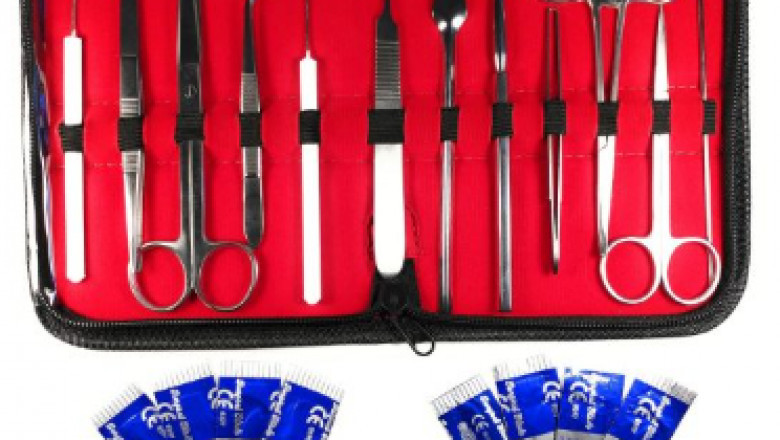views
Introduction
Precision and cleanliness are crucial in anatomical studies, surgical training, and biology labs — and a reliable dissecting set is essential to meet those standards. These kits offer a comprehensive solution for tissue dissection, providing professionals and students with the right tools for accurate results.
Whether for educational institutions, healthcare facilities, or research labs, a high-quality dissection kit ensures consistency, hygiene, and ease of use. This article explores the components, uses, benefits, and factors to consider when choosing a kit dissection tool.
What Is a Dissecting Set?
A dissecting set is a collection of surgical-grade instruments used to examine, cut, and separate tissues in a controlled and safe manner. These tools are commonly packed in a portable case or pouch and are designed to handle delicate as well as firm anatomical materials.
Depending on the application, a dissection kit may vary in instrument count and type — from basic sets for academic use to more comprehensive kits for surgical simulation and biological research.
Common Components of a Dissection Kit
The contents of a dissection kit can differ, but a standard set typically includes:
-
Scalpel Handle and Blades: For making precise incisions
-
Dissecting Scissors (Straight and Curved): To cut tissues with control
-
Forceps (Toothed and Non-toothed): For gripping and lifting tissues
-
Needle Probe and Seekers: Used to explore and isolate small anatomical structures
-
Dissecting Needles: For separating or manipulating tissue
-
Glass Dropper: Helpful in applying reagents or fluids
-
Ruler and Compass (in educational sets): To measure and guide dissection
-
Storage Case (Zippered or Snap Closure): Keeps tools organized and sterile
These tools are typically made from stainless steel to ensure corrosion resistance, reusability, and sterilization compatibility.
Applications of Dissecting Kits
Dissecting sets are used in various fields where tissue or specimen analysis is essential:
-
Biology and Anatomy Education: In schools, colleges, and medical universities
-
Medical and Veterinary Training: For practicing surgical incisions and identifying anatomical structures
-
Research Laboratories: During specimen dissection and sample preparation
Pathology and Forensics: For analyzing tissues in medical investigations -
Zoological and Botanical Studies: For dissecting flora or fauna in academic research
Advantages of Using a Professional Dissection Kit
Using a well-designed and high-quality dissecting set offers several advantages:
-
Precision: Ergonomically designed instruments ensure accurate cutting and manipulation.
-
Durability: Stainless steel tools are long-lasting, even with repeated use and sterilization.
-
Portability: Kits come with carrying cases, allowing easy transportation and fieldwork use.
-
Sterilization Friendly: Tools can be autoclaved or disinfected without degrading their quality.
-
Versatility: Applicable in a wide range of biological, anatomical, and surgical contexts.
Factors to Consider When Choosing a Dissection Kit
Not all dissection kits are created equal. When selecting a set, consider the following:
-
Material Quality: Look for medical-grade stainless steel to ensure longevity and safety.
-
Tool Variety: Ensure the set includes all essential tools based on the intended use.
Sterilization Compatibility: Tools should withstand autoclaving without rust or damage. -
Storage Case: A well-organized pouch or case maintains hygiene and prevents tool loss.
-
ISO Certification: Verify compliance with international standards to ensure quality assurance.
Types of Dissecting Sets Available
-
Basic Dissection Kit
-
Ideal for introductory anatomy courses
-
Usually includes 5–8 essential instruments
-
Advanced Dissecting Set
-
Includes 10–15+ instruments
-
Suitable for surgical training and detailed biological dissection
-
Customized Kits
-
Tailored to institutional or laboratory needs
-
May include additional instruments like tweezers, retractors, or scissors with specialized tips
Maintenance and Safety Tips
To ensure your kit dissection tools remain effective and safe:
-
Clean instruments after every use with appropriate disinfectants
-
Sterilize tools using autoclaves if they are reusable
-
Store the tools in the designated case to avoid damage
-
Replace dull or rusted instruments to prevent injury or specimen damage
-
Avoid sharing tools without proper sterilization to prevent cross-contamination
Global Demand and Importance
The demand for reliable dissection kits continues to grow in academic, scientific, and clinical environments worldwide. As life sciences and surgical education evolve, there is a consistent need for tools that offer accuracy, safety, and standardization.
Institutions rely on kits that meet strict quality assurance protocols, support consistent performance, and align with teaching or training objectives. A comprehensive dissecting set helps enhance the learning experience and supports professional development across sectors.
Conclusion
A well-equipped dissecting set is more than just a collection of tools—it's an essential part of training, discovery, and development in biology and medicine. Whether used for educational or clinical purposes, a quality dissection kit ensures reliable outcomes and a better understanding of anatomical structures.
Explore the full specifications and product offerings for high-grade kit dissection tools at GST Corporation Ltd, where quality and precision come together for excellence in medical equipment.






















Comments
0 comment